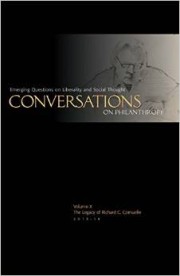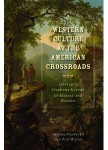(Twentieth-Century) Philanthropy in America
Olivier Zunz’ new history, Philanthropy in America, is a major contribution to philanthropic studies—thoroughly researched and documented, clearly narrated and argued, and illuminating a main theme in the history of twentieth-century American philanthropy: its development in civil society. Within the limits Professor Zunz has chosen, he has rendered a great service to the entire professional philanthropic community, both academic and practical, for which we should all be grateful.
That said, a full appreciation of this substantial study requires knowledge of both its content and its context—both the mountain of information and scholarship it so admirably synthesizes, and its chosen limits. Within those limits, this will be recognized as the standard, authoritative account for some time to come. Beyond those, however—contextually—is where the greater, more profound and influential history will ultimately be discovered.
The reason for this remarkable situation is that while this book was being researched, written, and published, its subject was being transformed. American philanthropy itself was—and still is—undergoing a classic paradigm shift. What this book describes so well is the period of the twentieth-century paradigm—now increasingly considered the “Old Paradigm,” and being superseded by an as-yet inchoate New Paradigm, outside Zunz’ purview. The book captures, in short, a kind of bubble within a longer and deeper “history” of “philanthropy in America.” Within the bubble, the book is excellent; in the larger context it is still very good, but increasingly passé, as philanthropy moves on into the future. The history of American philanthropy is turning out to have more numerous, more powerful, and more profound themes than the development of the twentieth-century academic, social-scientific constructs of an alleged “third sector” and “civil society.”
Space here does not allow a detailed account of the many subjects Zunz covers so well; this summary will focus therefore on the broad themes and structure of the bubble itself—the narrative framework.
Summarizing his “Conclusions”, Zunz writes: “As this history has shown, philanthropy in the United States is not simply the consequence of a universal altruistic impulse; it is also a product of the large organizational revolution that American managerial and financial capitalism orchestrated in the last century and a half” (294). Here he cites his own previous work, Making America Corporate, 1870-1920 (1990), along with the well-known works of Alfred Chandler (The Visible Hand, 1977) and Naomi Lamoreaux (The Great Merger Movement, 1985). For the “universal altruistic impulse” he cites only Adam Smith’s Theory of Moral Sentiments, and elsewhere Tocqueville—i.e., no Americans. “Americans…have turned a universal desire to do good into a distinct brand of philanthropy. They have learned to turn market profits and market methods into a philanthropic engine powerful enough to influence the course of their own history” (294). They “have come to think of philanthropy not as a gift only, but also as an investment….to openly combine ideas of managing the market and [charitable] giving in a single mechanism geared for social progress….providing for their own future” (295). As Tocqueville had noted, American generosity was “self-interest properly understood” (296).
He begins to unfold this story in the first chapter, “For the Improvement of Mankind,” which opens with a striking fact: that in two decades following the 1870s in America, “more people made more money more rapidly than ever before in history, and made very large gifts to society” (8). In the seventies there were 100 millionaires; in 1892, 4,047; by 1916, over 40,000, of whom at least two—John D. Rockefeller and Henry Ford—were billionaires. With too much money to spend personally or to contribute to traditional local welfare charities, the “new rich” created a “genuine American invention,” the “general purpose foundation” (22), involving “long-term alliances” with Progressive reformers trained in the social sciences to devise strategic investments in new institutions and programs aimed not at temporary symptomatic relief of social problems but long-term, fundamental, solutions to the root causes of those problems. Because these new institutions were intended to be permanent and to invest in research, new discoveries, and social engineering, they needed unspecified, strategic, general humanitarian mission statements. This required legal reform, to recognize and protect “open-ended” charitable bequests (e.g., “to the improvement of mankind”) as legitimate “charitable uses.”
In Chapter Two, “The Coming of Mass Philanthropy,” Zunz describes how systems also arose to mobilize huge numbers of small gifts by ordinary Americans, initially for the fight against tuberculosis, later for the World War I effort and its recovery, then for community improvement and poor relief during the Great Depression. Giving through churches, workplaces, and federated giving programs of community chests and community foundations encouraged American families to budget for charitable giving, a kind of “public thrift” which “gave philanthropy its democratic imprint in America” (295). Charitable giving had become “a routine part of American life” (75).
The new foundations and “mass philanthropy” created, together and in partnership with government, a new and powerful system of civil society, whose conspicuous potency evoked federal government interest in defining the proper relationship of private philanthropy to public politics and government—a recurrent theme throughout the book, and “a distinctive feature of American society” (297). The work of civil society called upon a broad range of technical and managerial skills and led to an increasing professionalization of philanthropy. The dialectic between professional philanthropists and government regulators consolidated an increasingly influential “third sector”—neither government nor business, tax-exempt, and privileged to raise tax-deductible donations and grants. Zunz posits tax exemption as the essential core of the third sector:
Tax exemption has not only nurtured philanthropy in society, it has entrenched it. Equally important, it encourages an otherwise very diverse group of institutions that have dispersed and/or solicited private funds for the public good to work together, in essence fostering a nonprofit sector of groups with similar interests and privileges.
The nonprofit sector is the outcome of this unique encounter between philanthropy and the state. It is a hybrid capitalist creation that operates tax-free so long as profits are reinvested in the common good….[R]evenues are designated for the support of beneficiaries rather than for the profit of stockholders (4).
Zunz asserts that the nonprofit sector has thus “become a distinct and pervasive part of the American political economy” (4). Moreover, he posits that twentieth-century philanthropy “should be understood as part of the American Progressive tradition,” mobilizing enormous energy across all social classes and resulting in a “network of foundations and community institutions [which] has enlarged American democracy” (7). This view summarizes what some today regard as the “myth” of the nonprofit sector, about which more below.
The next five chapters tell the story of how the new system and the federal government, through decades of war, economic depression, natural disasters, and international recovery from war, struggled to define the role of private initiatives in testing experimental approaches and providing technical assistance to governments in social problem-solving. “By the middle of the twentieth century,” Zunz observes, “Americans had created a large philanthropic enterprise that was part of the fabric of their daily lives….The nonprofit sector as a whole provided a medium through which Americans channeled their excess income to help the poor, to enhance children’s education, to promote cultural activities, to fund science, and to initiate agricultural reform in poor countries, all in partnership with government” (169).
The two last climactic chapters describe the full flowering of the “nonprofit sector” and its purported institutionalization in Independent Sector in 1980. “Most Americans acknowledged the existence of a ‘nonprofit sector’” (232). Liberals “promoted a sector balancing public and private sources of support….their fear was that the third sector might otherwise be absorbed into government” (233). Conservatives believed the federal government ought to leave social problem-solving entirely to philanthropy and state and local governments. “For thirty years [they] fought to make their idea of the nonprofit sector the accepted view of civil society. The nonprofit sector as we know it today emerged slowly from this confrontation” (233). “The nonprofit sector has come of age.” Supreme Court decisions “have made the nonprofit sector the institutional voice of American civil society….Conservatives and liberals, individually and collectively, made nonprofits worthy substitutes for the associations Tocqueville had heralded as engines of American liberty” (262-263).
The final chapter, “American Philanthropy and the World’s Communities” purports to show how American civil society has become a global force promoting democracy by working around governments and through NGOs, by defining development as improvement in quality of life rather than simply economic metrics (e.g., Amartya Sen), by mobilizing mass philanthropy techniques, and by promoting itself as a model for the rest of the world. The Internet is finally mentioned in the last seven pages (292-299), where Zunz acknowledges that “[i]ronically, the Internet and related high-speed communications, which are the most impersonal of means [!], have brought personal financial participation in the global associational revolution within reach of practically everybody.”
Zunz’ narrative, then, describes an onward-and-upward trajectory leading to global success. This is a case, however, in which the Devil is not in the details, which are admirable as far as they go, but in the over-all conceptualization and rhetorical structure, which are in turn a function of Zunz’ training as an American economic and business historian. He naturally sees twentieth-century American philanthropy in the context of his field and previous work, and within its own terms there is considerable merit and appropriateness in this orientation—which is why the book is as good as it is. Nonetheless, problems remain.
The main problems are: that the history of distinctively American philanthropy does not begin with the amassing of unprecedented wealth and the emergence of the social sciences at the end of the nineteenth century; that before then it was not confined to “universal altruistic impulse”; that recent and current empirical research has raised questions suggesting that the so-called “third” or “nonprofit sector” is not and never has been a coherent objective historical entity or phenomenon, much less “whose profits are reinvested for the common good,” but an artifact of the tax code and related state laws of incorporation; that scholars have not bothered to examine the data on which this concept is based; and that when the data is examined, “philanthropy” turns out to be only a small part of, and not at all coextensive with, “nonprofits” or an alleged “third” sector.
To begin with, Professor Zunz is certainly to be excused for not knowing—because very few American historians have noticed it either—that the locus classicus for adequately understanding distinctively American philanthropy is to be found on page one, paragraph one, of the first Federalist Paper, in which Alexander Hamilton launched the Founders’ argument for ratification of our Constitution, saying, “It is commonly remarked” that Americans were at a new place in history; that whereas previously governments had been the products of accident and force, Americans had the unique opportunity of choosing their own government. “This,” Hamilton wrote, “adds the inducements of philanthropy to those of patriotism.” He was not talking about rich people helping poor people, nor about a “universal altruistic impulse” of generosity, but about an educational and cultural tradition going back via the Enlightenment, the Renaissance, and Republican Rome, to Periclean Athens. He was saying that the United States of America was intended and designed to be a philanthropic nation, a gift to humanity, promoting democracy and freedom to be sure, but beyond even those, helping to make the world more fully humane in every sense of that word. An adequate “history” of “philanthropy in America” would therefore explore how Hamilton and the Founders got the idea of “the inducements of philanthropy” from the American and especially Scottish Enlightenments, and how they modeled the new government on the “voluntary associations” that Tocqueville would later observe had characterized Colonial culture, which were (in John Gardner’s words) “private initiatives for…public good,” which is to say the practical philanthropy of voluntarism and collaboration.
Armed with this knowledge, historians might apply it to the IRS Master Data File of so-called “third sector” and “nonprofit” institutions, where they would immediately find that very few have anything to do with “philanthropy.” In Massachusetts the Catalogue for Philanthropy did this research and found that 75 percent of tax-exempt entities are primarily self-serving (supported by, and providing benefits for, their own members), only about 10 percent are indisputably “private initiatives, for public good, focusing on quality of life, and engaged in public fund-raising (the philanthropic marketplace),” and the remaining 15 percent are “para-philanthropic”—between the two. Current research, in other words, is calling into question, on the basis of evidence, the fundamental assumptions or controlling “myth” of Zunz’ book cited above (4, 7): that “philanthropy” and “nonprofits” are roughly the same, that there is a “nonprofit sector” which is beneficial for public good and supported by grants and donations, and that the history of philanthropy in America is about the political economy of that sector in relation to government in the twentieth century.
Discontent with the Old Paradigm had certainly been expressed during its rise and dominance, perhaps most eminently by Richard Cornuelle’s Reclaiming the American Dream (1965). But by the end of the century a profound structural and strategic change was first heralded within the profession by two articles in Foundation News.1 Paradigm shifts are total transformations of the governing models of mature fields of endeavor. While Zunz’ book presents an excellent history of the rise of the paradigm which governed twentieth-century philanthropy, it is oblivious to the fallacies which have contributed to its current unraveling by the Internet, the globalization of the American high-tech economy, new demographics of wealth, social networking, and other factors. The twentieth-century vocabulary, conceptualization, rhetoric, technology, infrastructure, and modes of operation which have governed American philanthropy are all being transformed—superseded by new models which have not yet coalesced in a new paradigm, though that is inevitable.
Even taken on its own terms, the portrayal of philanthropy in this book is notably impersonal and bloodless—a matter of political economy academically considered, driven by large systems from the top down, focused on the interplay of national government with the so-called “third sector.” The wonderful world of myriad smaller charities, struggling creatively, intelligently, and compassionately at the grassroots level, with meager resources to improve Americans’ quality of life in the face of persistent and emergent public problems, is not Zunz’ subject and does not inform the perspective from which this history is written.
We must be enormously grateful to Professor Zunz for his major contribution to our scholarly literature because, within its own frame of reference, it is excellent. It does not detract in the slightest from this book to suggest that other histories are also needed.
George McCully served for twenty years as professor of European intellectual and cultural history, from the Renaissance to the Enlightenment, and for twenty-five years as a professional philanthropist—fundraiser, strategic planner, executive director, trustee, and advisor to charities, foundations, families and individual donors. In 1997 he created the highly respected and influential Massachusetts Catalogue for Philanthropy, to promote charitable giving and strengthen the culture of philanthropy through donor education. His book, Philanthropy Reconsidered (2008), presents a comprehensive overview of the “vocabulary, conceptualization, and rhetoric” of philanthropy from the ancient coinage of the term inPrometheus Bound, to its essential role informing the American Revolution and Constitution, to the paradigm-shift transforming philanthropy today. His latest work is the Massachusetts Philanthropic Directory—an on-line, systematically taxonomized, analytical directory to all the philanthropic charities of (initially) Massachusetts, which comprise only 1/7th of the state’s “nonprofits”. This dramatically innovative Directory system will be extended nationwide over the next two years. He is also a contributing editor to Conversations on Philanthropy. (REV. 2010)
NOTE
1George McCully, “Is This a Paradigm-Shift?” Foundation News and Commentary (March-April, 2000) 41 (2): 20-22 and “Are Foundations Being Marginalized? Further Notes on the Paradigm-Shift,” Council on Foundations, Washington, DC (September-October, 2000) 41 (5): 30-31.






